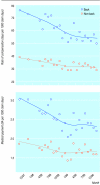Population based intervention to change back pain beliefs and disability: three part evaluation
- PMID: 11420272
- PMCID: PMC33390
- DOI: 10.1136/bmj.322.7301.1516
Population based intervention to change back pain beliefs and disability: three part evaluation
Abstract
Objective: To evaluate the effectiveness of a population based, state-wide public health intervention designed to alter beliefs about back pain, influence medical management, and reduce disability and costs of compensation.
Design: Quasi-experimental, non-randomised, non-equivalent, before and after telephone surveys of the general population and postal surveys of general practitioners with an adjacent state as control group and descriptive analysis of claims database.
Setting: Two states in Australia.
Participants: 4730 members of general population before and two and two and a half years after campaign started, in a ratio of 2:1:1; 2556 general practitioners before and two years after campaign onset.
Main outcome measures: Back beliefs questionnaire, knowledge and attitude statements about back pain, incidence of workers' financial compensation claims for back problems, rate of days compensated, and medical payments for claims related to back pain and other claims.
Results: In the intervention state beliefs about back pain became more positive between successive surveys (mean improvement in questionnaire score 1.9 (95% confidence interval 1.3 to 2.5), P<0.001 and 3.2 (2.6 to 3.9), P<0.001, between baseline and the second and third survey, respectively). Beliefs about back pain also improved among doctors. There was a clear decline in number of claims for back pain, rates of days compensated, and medical payments for claims for back pain over the duration of the campaign.
Conclusions: A population based strategy of provision of positive messages about back pain improves population and general practitioner beliefs about back pain and seems to influence medical management and reduce disability and workers' compensation costs related to back pain.
Figures


References
-
- Linton S. A review of psychological risk factors in back and neck pain. In: Nachemson A, Jonsson E, editors. Neck and back pain: the scientific evidence of causes, diagnosis, and treatment. Philadelphia: Lippincott Williams & Wilkins; 2000.
-
- Waddell G, Newton M, Henderson I, Somerville D, Main CJ. A fear-avoidance beliefs questionnaire (FABQ) and the role of fear avoidance beliefs in chronic low back pain and disability. Pain. 1993;52:157–168. - PubMed
-
- Burton AK, Tillotson KM, Main CJ, Hollis S. Psychosocial predictors of outcome in acute and subchronic low back trouble. Spine. 1995;20:722–728. - PubMed
-
- Symonds TL, Burton AK, Tillotson KM, Main CJ. Do attitudes and beliefs influence work loss due to low back trouble? Occup Med. 1996;46:25–32. - PubMed
-
- Waddell G. A new clinical model for the treatment of low-back pain. Spine. 1987;12:632–644. - PubMed
Publication types
MeSH terms
LinkOut - more resources
Full Text Sources
Medical
